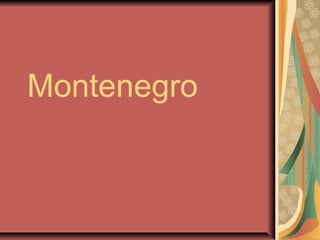
Montenegro
- 1. Montenegro
- 2. Historia El actual territorio de Montenegro estuvo habitado durante siglos después de la caída del Imperio Romano de Occidente por diversas tribus eslavas, mezcladas con ávaros, ilirios y romanos, producto del dominio de estos pueblos sobre la región. Dichas tribus durante el siglo X formaron un principado llamado Doclea (Duklja), cuya independencia fue reconocida por el Papa Gregorio VII en 1077 pero que se mantuvo como tributario del Imperio bizantino. Sin embargo, en 1186 fue conquistada por Stefan Nemanja,Gran Príncipe del reino serbio de Rascia.
- 3. ¿Qué ver en Montenegro? Durante la década de 2000, el turismo fue uno de los sectores económicos de mayor crecimiento, y poco a poco el país se ha ido consolidando como uno de los principales puntos turísticos de la región.
- 4. IDIOMAS El idioma oficial del país es el montenegrino, reconocido tras la aprobación de la Constitución montenegrina de 2007. El montenegrino es una forma estandarizada del shtokaviano, un dialecto serbocroata. Anteriormente fue utilizada la nomenclatura serbio, y antes de 1992 la de serbocroata. En el último censo, el 42,88% de la población afirmó tener al serbio como lengua materna, mientras sólo el 36,97% se refirió al montenegrino. En el censo 2003 el porcentaje que se refirió a su lengua como serbio fue del 63,5% de la población, mientras sólo el 22% lo hizo como montenegrino.
- 5. Deportes Los deportes más populares son el baloncesto y el fútbol pero ningún equipo montenegrino en estos deportes ha logrado algún triunfo importante. Montenegro entró a formar parte de la estructura del Comité Olímpico Internacional, durante la 112.ª sesión de este organismo que tuvo lugar en Ciudad de Guatemala, el 6 de julio de 2007, y su debut se realizó en los Juegos Olímpicos de Pekín 2008. La FIBAfue la primera institución en aceptarlo como miembro, después de aceptar su inclusión como el 213.ª afiliado, el 28 de agosto de2006
- 6. Demografía Montenegro tiene una población de 620,029 según el último censo, realizado el año 2011, correspondientes a una densidad poblacional de 44,7 hab/km².La composición étnica del país es, al igual que en la mayoría de las antiguas repúblicas yugoslavas, compleja y de gran importancia para el desarrollo del país. El grupo predominante es el de los montenegrinos, principalmente en las zonas centrales del territorio seguidos por los serbios, ubicados en la zona septentrional del país.
- 7. Religión Según el censo de 2011, el 72,07% de los habitantes de Montenegro pertenecen a la Iglesia Ortodoxa, cuyos adeptos se dividen entre la Iglesia ortodoxa serbia y la Iglesia ortodoxa montenegrina creada en 1993. El 19,11% de la población del país afirma pertenecer al Islam, los cuales corresponden principalmente a albaneses, bosnios y al grupo de eslavos musulmanes. En tanto, la fe católica es seguida por el 3,44%, siendo más practicada en las zonas costeras. Los no religiosos suponen el 1,31% de los censados, mientras que el 2,61% no se declara al respecto. Otros grupos minoritarios censados son cristianos de diversa denominación y budistas.
- 8. FIN